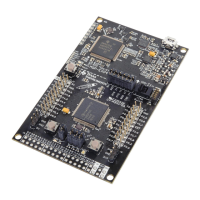8 Loadable BSL
9 Exiting the BSL
10 Password Protection
Loadable BSL
For upgrading the BSL functionality, sometimes it is suitable to load a higher version of BSL into the RAM
of a device and apply the latest innovations. To do so, use the following BSL commands:
• RX password (unlock password protection for following commands)
• RX data block (code of loadable BSL, code section address ≥ 220h)
• TX data block (for verification)
• RX data block (get start address from first code section address)
• Load program counter PC (with start address of loadable BSL)
• Wait at least 5 ms until the new loaded BSL has executed the initialized routine
• RX password (unlock password protection for loaded BSL)
• Perform any command (with loaded BSL)
The following loadable BSLs are available:
• BL_150S_14x.txt is a complete BSL for the F14x/F13x family with BSL version 1.10. All features of
BSL version V1.60 are supported. Because its code size is bigger than 1K byte, it can be used only in
F1x8 and F1x9 devices. The error address buffer address for "RX Block", "Erase Segment", and
"Erase Check" commands is 021Eh. BL_150S_14x.txt could also be used as a replacement for
PATCH.txt.
• BS_150S_14x.txt is a small BSL with reduced command set for the F14x/F13x family with BSL version
1.10. Because its code size is smaller than 512B, it can be used in F1x4 upto F1x9 devices. The
following commands of BSL version V1.60 are supported: Change Baudrate, RX Block (with online
verification), Erase Check, and Load PC. If a TX Block command (redirected to ROM BSL) is needed
(e.g., for transmitting error address or standalone Verify), the RAM BSL must be invoked again via the
Load PC command. The error address buffer address for RX Block and Erase Check commands is
021Eh. BS_150S_14x.txt could also be used as a partial replacement for PATCH.txt. Note that no
password is required, as the RX password command is stripped!
For more information on downloading a different bootstrap loader, see Application of Bootstrap Loader in
MSP430 With Flash Hardware and Software Proposal (SLAA096).
Third-party software normally uses loadable BSLs to perform most functions, like online verification, and to
improve speed for appropriate devices.
To exit the BSL mode, two possibilities are provided:
• The microcontroller continues operation at a defined program address invoked by the load program
counter command. Be aware of that the password protection is not active at this time. In this case, the
user application should ensure that the flash is locked, as this is not done by the BSL. Leaving the BSL
unlocked increases the risk of erroneously modifying the flash do to system or software errors. On ‘2xx
devices, the correct setting of the LOCKA bit should also be checked.
• Applying the standard RESET sequence (see Figure 1 ) forces the MSP430 to start with the user reset
vector at address 0FFFEh.
The password protection prohibits every command that potentially allows direct or indirect data access.
Only the unprotected commands like mass erase and RX password (optionally, TX BSL version and
change baud rate) can be performed without prior receipt of the correct password after BSL entry.
Applying the RX password command for receiving the correct password unlocks the remaining
commands.
Once it is unlocked, it remains unlocked until initiating another BSL entry.
The password itself consists of the 16 interrupt vectors located at addresses FFE0h to FFFFh (256 bits),
starting with the first byte at address FFE0h. After mass erase and with unprogrammed devices, all
password bits are logical high (1).
12 Features of the MSP430 Bootstrap Loader SLAA089D – December 1999 – Revised August 2006
Submit Documentation Feedback

